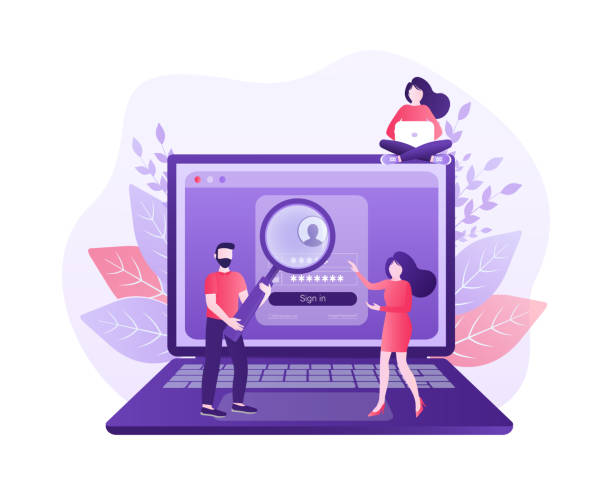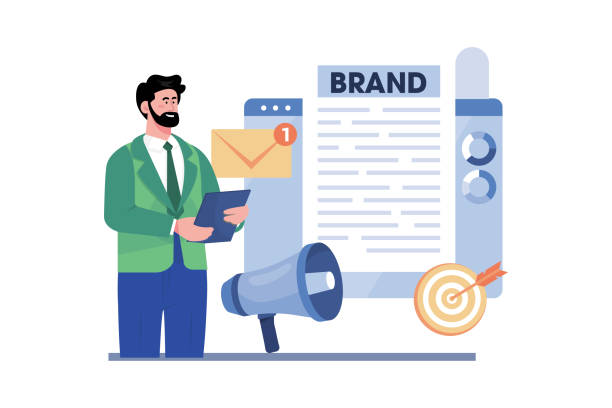The Importance and Rationale of E-commerce Website Design

In the current digital age, a strong online presence is essential for any business seeking growth and development.
E-commerce website design is no longer a luxury choice; it’s a vital necessity.
This allows businesses to offer their products and services beyond geographical boundaries to potential customers worldwide.
Among the most important reasons for the importance of #onlinestoredesign is 24/7 access, which allows customers to shop at any time and place convenient for them.
This capability eliminates the limitations of physical sales and provides countless opportunities for increasing revenue.
Also, the operational costs of an online store are significantly lower compared to a physical store.
There is no need to pay heavy rents, salaries for numerous staff, and physical maintenance costs.
This helps businesses achieve higher profitability and offer more competitive prices.
Designing an e-commerce website, in addition to reducing costs, provides the opportunity to collect valuable data on customer behavior.
By analyzing this data, purchasing patterns, popular products, and weaknesses can be identified, and marketing strategies can be optimized.
This #analytical approach helps businesses make more informed decisions and improve user experience.
Furthermore, creating an online store is a way to build and strengthen a brand.
With attractive visual design, rich content, and a smooth user experience, customer trust can be gained, and their loyalty increased.
In fact, it is also an #educational tool for customers to get complete and accurate information about products.
The e-commerce market is rapidly growing, and not having a presence in this space means losing a large share of the market.
An online store not only allows you to compete with larger rivals but also provides opportunities to discover new markets and niche segments.
This platform offers an #explanatory and comprehensive way to clarify product features interactively.
The ability to compare products, view others’ reviews, and access supplementary information are all benefits of this platform that help buyers make better decisions.
Therefore, investing in building an online store is crucial not only for survival in today’s market but also for flourishing and progressing in the near future.
This process must be carried out with care and planning to achieve the best results.
Are you tired of your company’s website not meeting your expectations? With RasaWeb, design a professional website that truly represents your business.
✅ Increase attraction of new customers and sales leads
✅ Increase your brand’s credibility and trust among your audience
⚡ Get a free website design consultation!
Essential Features of a Successful E-commerce Website
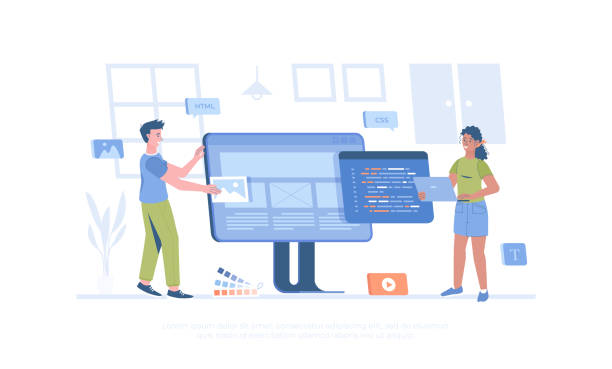
For an #onlinestore to be truly successful and meet your business goals, it must have a set of key features.
The first and perhaps most important feature is #responsivedesign.
Given the increasing use of mobile devices for online shopping, it is essential that your site displays correctly and provides a consistent user experience on every screen size, from smartphones to tablets and desktops.
This feature directly impacts SEO and customer satisfaction, and for this reason, it holds high importance in e-commerce website design.
The second vital feature is a comprehensive and high-quality product catalog.
Each product must have multiple high-quality images, detailed and complete descriptions, clear pricing, and inventory information.
Advanced filtering and search capabilities help customers easily find the product they are looking for, which is a #specialized and very practical feature.
A user-friendly shopping cart and a simple and fast checkout process are also essential requirements.
Any complexity at this stage can lead to cart abandonment and loss of customers.
Offering diverse and secure payment options also plays a significant role in increasing conversion rates.
The ability to register a user account and view purchase history, write reviews and rate products, and create a Wishlist all help improve the customer experience and make users feel respected in your online store.
An efficient and extensible Content Management System (CMS) for easy management of products, orders, customers, and site content is also among the essential features.
High page load speed and search engine optimization (SEO) are also determining factors for the success of an e-commerce website.
A faster site not only provides a better user experience but also performs better in search engine rankings.
All these elements, together, provide a powerful and efficient platform for e-commerce website development.
Also, providing customer support via online chat, phone, or email and an FAQ (Frequently Asked Questions) section is a #guidance and very important element that increases customer trust.
Having a #news or blog section for publishing articles and content related to products or the industry can help attract organic traffic and improve SEO.
Finally, website security against cyber-attacks and protecting user privacy is also of particular importance.
Using an SSL certificate and regular system updates are essential measures in this regard.
These features set a standard for e-commerce website design that should be considered in every project.
Choosing the Right Platform for Your E-commerce Website Design
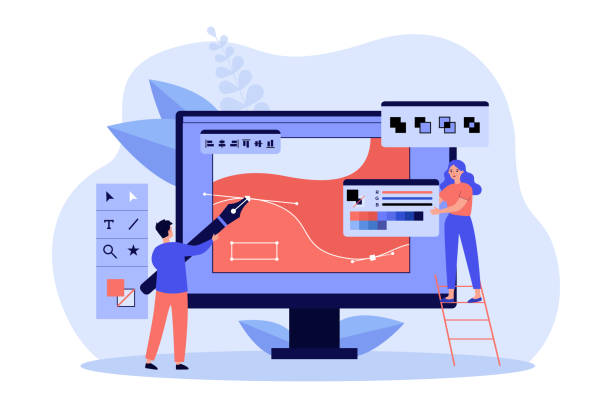
One of the most important decisions in the #onlinestoredesign journey is choosing the right platform.
This choice will directly impact the site’s capabilities, costs, scalability, and ease of management.
Various platforms exist for creating an online store, each with its own advantages and disadvantages, requiring a precise #analytical review.
Among the most popular options are WooCommerce for WordPress, Shopify, and Magento.
WooCommerce is a free plugin for WordPress that allows you to build a highly customizable e-commerce site.
This option is ideal for small to medium-sized businesses looking for high flexibility and full control over their site’s content.
However, it requires more technical knowledge for setup and maintenance.
Shopify is a hosted platform (SaaS) that is very easy to use and does not require high technical knowledge.
This option is suitable for those who want to quickly set up an online store with minimal hassle, but you will have less control over the code and infrastructure of your site, and its monthly costs can be high.
Magento is a very powerful and #specialized platform for designing large and complex e-commerce websites.
This platform provides numerous capabilities for customization, managing multiple stores, and handling high volumes of orders, but its setup and maintenance are very costly and require a team of expert developers.
In addition to these platforms, other options such as PrestaShop or even fully custom #onlinestoredesign exist.
The choice between these platforms should be based on your business’s specific needs, budget, level of technical knowledge, and future growth plans.
Here is a table for a general comparison of these platforms to #guide you in your choice:
| Feature | WooCommerce (WordPress) | Shopify | Magento |
|---|---|---|---|
| Ease of Use | Medium (requires technical knowledge) | Very Easy | Difficult (requires specialist) |
| Initial Cost | Low (hosting only) | Medium (monthly subscription) | High (development and hosting) |
| Customizability | Very High | Medium | Very High |
| Scalability | Good to Excellent (with proper infrastructure) | Excellent | Excellent (for large businesses) |
| Security | User’s responsibility | Managed by the platform | User’s responsibility |
| Support | Community and plugins | Official 24/7 support | Community and enterprise support |
This choice must be made carefully, as changing platforms in the future can be complex and costly.
A thorough study of your business’s current and future needs will help you make the best decision for creating your online store.
Consulting with website design specialists can also be very helpful in this process.
This decision forms the foundation for your long-term success in e-commerce.
User Experience (UX) and User Interface (UI) in E-commerce Website Design
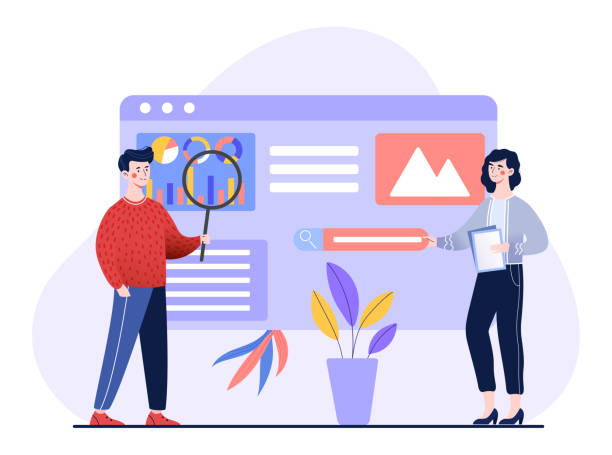
In the competitive world of e-commerce website design, User Experience (UX) and User Interface (UI) are two vital elements that determine the success or failure of an online store.
UX refers to the user’s overall feeling when interacting with the site; how easy, efficient, and enjoyable it is.
UI addresses the visual and interactive aspects of the site, such as buttons, icons, fonts, and colors.
Both are complementary and must be carefully considered to create a successful #onlinestore.
Good UX makes it easy for users to navigate the site, find the product they want, and complete the purchase process without any problems.
This directly affects your #conversionrate and sales.
One of the most important aspects of UX is #pageloadspeed.
Today’s users are very impatient, and even a few seconds’ delay can cause them to leave the site.
Optimizing images, using efficient code, and choosing suitable hosting are among the actions that help improve speed.
Responsive Design is also an integral part of UX, ensuring that your site displays correctly on all devices, from mobile to desktop.
Simple and intuitive Navigation is also essential for ideal UX.
Clear menus, logical categories, and powerful search capabilities help users quickly find what they need.
These elements provide suitable #guidance for users.
In terms of UI, the design should be attractive yet functional.
Using appropriate colors, readable fonts, and high-quality images all contribute to the visual appeal of the site.
But this beauty should not sacrifice usability.
Buttons should be clear and clickable, forms should be simple and understandable, and important information should be easily discernible.
Design consistency is also very important; similar elements should behave uniformly across the site so that users are not confused.
These are #specialized tips that every e-commerce website designer should pay attention to.
The checkout process should also be as simple and straightforward as possible.
Eliminating extra steps, offering various payment options, and transparently displaying costs (including taxes and shipping fees) can prevent cart abandonment.
Additionally, providing visual feedback, such as confirmation of a product being added to the cart or showing progress in the payment stages, reassures the user.
Finally, paying attention to small details such as friendly error messages or attractive 404 page designs can improve the user experience.
With a #thoughtprovokingcontent approach to design, weaknesses can be identified, and necessary optimizations can be made so that users have an #engaging and at the same time efficient experience.
This investment in building an online store means investing in customer loyalty and increased sales.
Did you know that 94% of a company’s first impression is related to its website design?
RasaWeb, by providing professional corporate website design services, helps you make the best first impression.
✅ Creates a professional and trustworthy image for your brand
✅ Helps attract targeted customers and improve online standing
⚡ Contact RasaWeb for a free corporate website design consultation!
Secure Payment Gateways and Customer Data Security
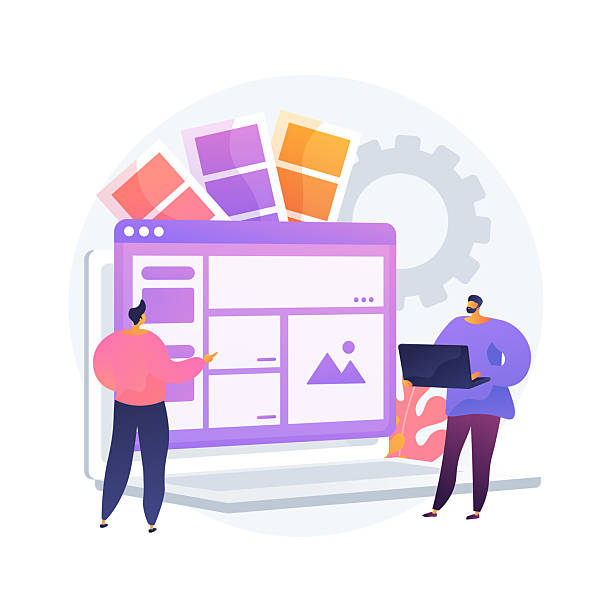
Security is the backbone of any successful #onlinestoredesign.
In the online environment, where sensitive financial and personal customer information is exchanged, guaranteeing the security of the website and user data is of vital importance.
Failure to address this can lead to loss of customer trust, damage to brand reputation, and even legal consequences.
Choosing a secure and reliable payment gateway is the first step in this direction.
These gateways are responsible for processing financial transactions in an encrypted manner and must adhere to high-security protocols.
For online stores in Iran, payment gateways from domestic banks such as Mellat, Saman, Pasargad, or intermediary companies like ZarinPal and IDPay are commonly used, all of which have the necessary security standards.
In addition to the payment gateway, using an SSL (Secure Sockets Layer) security certificate is essential for every e-commerce website.
SSL encrypts information exchanged between the user and the server and prevents data interception or manipulation.
This not only enhances security but also builds user trust, as the presence of a green lock icon in the browser’s address bar assures them that the site is secure.
This is a #specialized and very important point in the e-commerce website design process.
Protecting customer privacy and personal information is also of particular importance.
The website must comply with PCI DSS (Payment Card Industry Data Security Standard), especially if it directly processes credit card information (which is typically done by payment gateways in Iran).
Storage of personal information should be minimal and encrypted, and access to it should be restricted to authorized personnel.
A clear and transparent Privacy Policy should also be available on the site, informing users how their information is collected, used, and protected.
This policy should be easily accessible to users and form an important #explanatory section.
Regular updates of systems, plugins, and site templates are also crucial to prevent security vulnerabilities.
Many cyber-attacks occur through weaknesses in outdated software.
Using a firewall (WAF), security scanners, and continuous monitoring of site activities can also help identify and counter security threats.
These #news measures help you stay aware of the latest threats and protect your site.
Furthermore, educating employees about best practices for information security and adhering to security protocols is an integral part of the overall security strategy for e-commerce website design.
In summary, investing in security not only protects your and your customers’ information but also significantly contributes to building a foundation of trust for your business’s sustainable growth.
This proactive approach ensures long-term success in online sales.
Search Engine Optimization (SEO) in E-commerce Website Design

For your e-commerce website design to be truly successful, users must be able to find it.
This is where Search Engine Optimization (SEO) comes into play.
SEO is a set of techniques and strategies aimed at improving your site’s ranking in search engine results like Google.
For an #onlinestore, this means attracting more organic traffic, which can lead to increased sales.
Without SEO, even the best products and most attractive design may not be seen.
The first step in SEO for e-commerce sites is keyword research.
You need to know what phrases your potential customers use to search for your products or services.
These keywords should be used in page titles, product descriptions, meta descriptions, and blog content.
This section is an important #educational process for every online business owner.
On-Page SEO involves optimizing your site’s internal elements.
This includes Page Titles, Meta Descriptions, heading tags (H1, H2, H3), image optimization (using Alt Text), and high-quality, unique content for each product and category page.
Ensure that each product page has comprehensive and engaging descriptions that naturally include relevant keywords.
Page load speed is also an important SEO factor; search engines prefer faster sites.
Also, Responsive Design is essential, as Google increasingly emphasizes user mobile experience.
Off-Page SEO involves activities performed outside your site that help improve its authority, such as link building (Building Backlinks) from other reputable sites.
The more reputable sites link to you, the more authoritative search engines consider your site to be.
Social media can also act as an indirect signal for SEO, but the main focus should be on quality content and natural link building.
Creating #specialized and valuable content in the form of blogs, guides, or educational articles can help attract natural links and establish your site as a credible information source in your field.
This is an #analytical approach to continuous SEO improvement.
Technical SEO involves optimizing the technical aspects of the site that help search engines crawl and index your site more easily.
This includes creating an XML sitemap, robots.txt file, using structured data (Schema Markup) to display rich information in search results (such as price, availability, and reviews), and fixing 404 errors.
The better search engines understand your site, the higher your chances of ranking.
E-commerce website design, considering SEO principles from the outset, helps you build a strong foundation for your online success from the start and drive targeted and high-converting traffic to your e-commerce website.
Marketing and Promotion Strategies for E-commerce Websites

Simply designing an e-commerce website is not enough; for this investment to pay off, effective marketing and promotion must be done.
There are various digital marketing strategies, each of which can help attract new customers, increase sales, and strengthen your brand.
The correct selection and combination of these strategies are crucial for every #onlinestore and require an #analytical approach to achieve the best return.
One of the most powerful marketing tools is Content Marketing.
Creating valuable content related to your products, such as blog articles, guides, videos, and infographics, not only helps improve SEO but also attracts your target audience.
This content can be #educational and answer common customer questions, or even be #engaging and make customers spend more time on your site.
Social Media Marketing is also very effective for e-commerce websites.
By being active on platforms like Instagram, Telegram, Facebook, and Twitter, you can interact with your audience, introduce new products, run advertising campaigns, and drive traffic to your site.
Paid Advertising (PPC) on search engines (like Google Ads) and social media can also quickly attract targeted traffic to your site.
This method is very effective for short-term campaigns or introducing new products.
Email Marketing is still one of the most effective ways to communicate with current and potential customers.
Collecting email addresses (with user permission) and sending newsletters, special offers, new product information, and abandoned cart reminders can help increase customer loyalty and repeat purchases.
This is a #specialized method for maintaining customer relationships.
Collaborating with influencers (Influencer Marketing) and affiliate marketing (Affiliate Marketing) are other strategies that can expand your reach to new audiences and increase sales.
Here is a table for some of the most popular digital marketing channels and their uses:
| Marketing Channel | Description | Key Benefits |
|---|---|---|
| Content Marketing | Creating and publishing valuable content (blog, video, infographic) | SEO improvement, organic traffic, credibility building |
| SEO | Optimizing the site for higher ranking in search results | High organic traffic, lower cost in the long run |
| Social Media Marketing | Activity on social platforms (Instagram, Telegram, Facebook) | Customer interaction, brand awareness, direct traffic |
| Paid Advertising (PPC) | Advertising on search engines and social media (Google Ads, Facebook Ads) | Fast results, targeted traffic, scalability |
| Email Marketing | Collecting emails and sending newsletters, discounts, notifications | High ROI, customer loyalty, direct communication |
| Affiliate Marketing | Collaborating with publishers to promote products for a commission | Pay-per-sale, access to new audiences |
Combining these strategies according to your budget and goals can help maximize the return on investment from your e-commerce website design.
Continuous monitoring and analysis of marketing campaign results are also essential for optimizing and improving future performance.
This #guidance will help you develop a comprehensive and effective marketing strategy for your online store.
Maintenance and Scalability of E-commerce Websites

Designing an e-commerce website is just the beginning; after launch, regular maintenance and planning for scalability are of particular importance.
An e-commerce website is like a living organism that needs continuous care to survive and grow.
Proper maintenance ensures optimal site performance and prevents potential problems.
Scalability refers to the site’s ability to handle increased traffic, order volume, and new product additions without performance degradation.
These two factors are key to the long-term success of an #onlinestore.
The first and most important aspect of maintenance is #regularupdates.
Platform software (such as WordPress/WooCommerce or Magento), plugins, themes, and the server must be continuously updated.
These updates not only add new functionalities but also fix security vulnerabilities and improve site performance.
Failure to update can leave your site vulnerable to cyber-attacks.
Regular Backups of site data and the database are also crucial.
In case of any serious problem, such as server failure or a cyber-attack, you can easily restore your site from a backup and prevent the loss of important data.
This is a #specialized and mandatory recommendation.
Performance Monitoring of the site, including load speed and server response time, is also an important part of maintenance.
Tools like Google PageSpeed Insights or GTmetrix can help you identify performance bottlenecks.
Any drop in speed can disrupt the user experience and negatively impact SEO.
Additionally, you should continuously check for and fix Broken Links, missing images, and other site errors.
An error-free site provides a better user experience and performs better in search results.
In terms of scalability, choosing the right infrastructure from the outset is important.
If you expect significant growth, shared hosting may not be sufficient, and you will need Virtual Private Servers (VPS) or Dedicated Servers, or even Cloud Hosting solutions.
Optimized #databasedesign and using techniques like caching and a Content Delivery Network (CDN) can help manage high traffic.
In e-commerce website design, the site’s architecture should allow for adding new products, categories, and functionalities in the future without the need for a complete redesign.
This planning for future growth is a #thoughtprovokingcontent approach that indicates whether your business is ready for the future or not.
These #guiding actions ensure that building your online store will be a long-term and sustainable investment.
Are you worried your company’s old website might scare away new customers? RasaWeb solves this problem with modern and efficient corporate website design.
✅ Increases your brand’s credibility.
✅ Helps attract targeted customers.
⚡ Contact RasaWeb for a free consultation!
Common Mistakes in E-commerce Website Design and Ways to Avoid Them

Even with the best intentions and planning, mistakes can occur in #onlinestoredesign that can negatively impact the overall success of the project.
Recognizing these common mistakes and knowing how to avoid them can help you create an efficient and profitable online store.
One of the biggest mistakes is #slowpageloadspeed.
As mentioned earlier, today’s users are impatient, and if your site takes more than a few seconds to load, they are likely to leave it.
To avoid this problem, optimizing images, compressing code, using caching, and choosing quality, high-speed hosting are essential.
This is a #specialized and critical tip.
Another common mistake is #pooruserexperience on mobile.
Many businesses still design their sites only for desktop and overlook the fact that a large portion of traffic and purchases come from mobile devices.
Ensuring that your e-commerce website design is fully responsive and mobile-friendly is essential.
#complexcheckoutprocess is another major reason for abandoned carts.
Customers want to complete the purchase process quickly and without hassle.
Reducing payment steps, offering a guest checkout option (without needing to register), and transparently displaying final costs (including taxes and shipping fees) can significantly increase your conversion rate.
This is practical #guidance for improving the user experience.
Failure to provide #insufficientproductinformation is also a big mistake.
Customers cannot touch or see the product up close, so high-quality images from different angles, comprehensive descriptions, features, technical specifications, and other customer reviews are essential to help them make a decision.
This information should be #explanatory so that no ambiguity remains for the customer.
Ignoring #customerservice after sale can also damage your brand’s reputation.
A strong support system, including online chat, phone, email, and an FAQ section, assures customers that someone is there to help them if a problem arises.
These services not only help solve problems but can also turn customers into loyal buyers.
Finally, neglecting #SEO from the start is a costly mistake.
Many businesses think about SEO after completing their e-commerce website design, while SEO principles should be considered from the very early stages of design so that your site is optimized for search engines from the beginning.
Also, failure to regularly update content and product information can lead to a stagnant site.
An active blog and regularly adding new products keep your site dynamic.
These common mistakes give you the opportunity to learn from them with a #thoughtprovokingcontent approach and avoid repeating them in building your online store.
Future and Emerging Trends in E-commerce Website Design
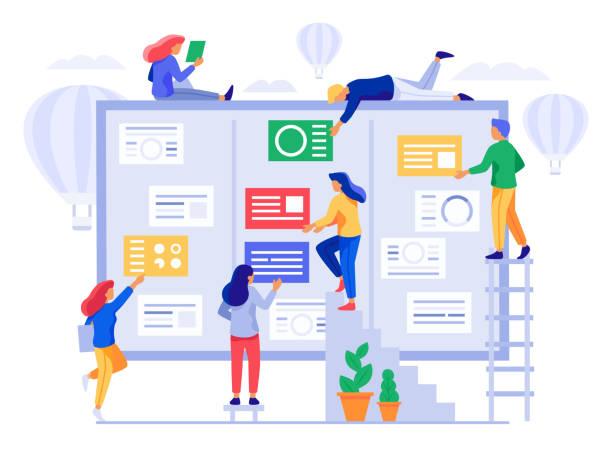
The world of e-commerce website design is constantly evolving, and keeping up with emerging trends is essential for maintaining competitiveness and long-term success.
New technologies and changing customer expectations determine the shape of the future #onlinestore.
Understanding these trends and incorporating them into your e-commerce website design strategies can differentiate your business from competitors.
One of the most important upcoming trends is #personalizingshoppingexperience.
Using Artificial Intelligence (AI) and Machine Learning, e-commerce sites can personalize product recommendations, content, and even page layouts based on each user’s behavior and preferences.
This makes the shopping experience unique and more engaging for each individual, ultimately leading to an increase in conversion rates.
This #analytical approach to customer data forms the foundation of personalization.
Augmented Reality (AR) and Virtual Reality (VR) are also slowly entering the e-commerce space.
AR allows customers to virtually view products in their real-world environment before purchase (e.g., trying on clothes, arranging furniture at home).
This technology, especially for apparel, home decor, and cosmetics, can revolutionize the shopping experience and reduce hesitation.
This is an exciting #news trend that shapes the future of e-commerce website design.
Voice Commerce is also growing.
With the increasing popularity of voice assistants like Siri, Google Assistant, and Alexa, shopping through voice commands has become a reality.
E-commerce websites need to be optimized for this type of interaction and make the voice search and purchase process simple and efficient.
This requires a deep understanding of how users ask #thoughtprovokingcontent questions in voice search.
Attention to #sustainability and social responsibility is also becoming an important factor for consumers.
Customers are increasingly looking for brands that adhere to ethical and environmental values.
#onlinestoredesign can showcase these commitments through dedicated sections, transparent information about product sourcing and production processes, and partnering with charitable or environmental organizations.
Finally, #advancedsecurity and data privacy will remain central.
With increasing cyber threats and privacy concerns, customers are looking for online stores that handle their data with care and high security.
Investing in new security technologies and transparency in privacy policies increases customer trust.
All these trends are moving towards creating an #engaging, personalized, secure, and responsible shopping experience.
Being a pioneer in these areas will help you prepare your e-commerce website design for the future and gain a competitive advantage.
Frequently Asked Questions
| Question | Answer |
|---|---|
| What is e-commerce website design? | E-commerce website design refers to the process of building and developing an online platform that allows users to purchase products or services online. This includes user interface design, user experience, security, shopping cart, and payment gateway. |
| Why is having an e-commerce website important for businesses? | Having an e-commerce website allows businesses to be active 24/7, expand their target market, reduce operational costs, and provide easier access for customers to their products. |
| What are the most important features of a successful e-commerce website? | The most important features include excellent User Interface and User Experience (UI/UX), high page load speed, security (SSL and secure payment gateway), Responsive Design, Search Engine Optimization (SEO), and easy management of products and orders. |
| What is the role of SEO in e-commerce website design? | SEO helps your e-commerce website rank higher in Google and other search engine results. This leads to an increase in organic visitors and, ultimately, an increase in sales. |
| What is the importance of security in e-commerce websites? | Security is crucial for protecting sensitive customer information (such as banking and personal data). Using an SSL certificate, secure payment gateways, and adhering to security standards builds customer trust and prevents fraud. |
| What are the common platforms for e-commerce website design? | Common platforms include WooCommerce (for WordPress), Shopify, Magento, PrestaShop, as well as custom development, each with its own advantages and disadvantages. |
| What does Responsive Design mean for an e-commerce website? | Responsive Design means that your e-commerce website displays correctly and optimally on any device (mobile, tablet, laptop). This is very important for user experience and SEO. |
| How can User Experience (UX) be improved in an e-commerce website? | User experience can be improved by simplifying the purchase process, easy navigation, attractive visual design, providing complete product information, customer reviews, and online support. |
| What is the role of product images and descriptions in an e-commerce website? | High-quality images and complete, accurate product descriptions help customers make better decisions and trust the product. This directly impacts the Conversion Rate. |
| What is the importance of customer support in e-commerce websites? | Strong and prompt customer support increases customer satisfaction and loyalty. Providing various support channels (phone, online chat, email) and responding to questions and resolving issues enhances the store’s credibility. |
And other services of Rasa Web Advertising Agency in the field of advertising
Smart SEO: A novel service for increasing user engagement through attractive UI design.
Smart Custom Software: Revolutionize digital branding with attractive UI design.
Smart Reportage: A combination of creativity and technology for digital branding through intelligent data analysis.
Smart Marketing Automation: A dedicated service for growth in customer acquisition based on marketing automation.
Smart Digital Branding: An effective tool for customer acquisition with the help of attractive UI design.
And over hundreds of other services in the field of online advertising, advertising consultation, and organizational solutions
Online Advertising | Advertising Strategy | Advertorial
Sources
E-commerce Website Design Guide on Iran DL
From Zero to One Hundred of E-commerce Website Design by WebRamz
Complete Guide to E-commerce Website Design by Host Iran
E-commerce Website Building Tutorial by RaymonWeb
? Are you ready to take your business to new heights in the digital space? RasaWeb Afarin Digital Marketing Agency, with years of experience in providing innovative solutions, including WordPress website design, SEO, and advertising campaign management, is your partner on the path to success. With us, your business’s future is brighter.
📍 Tehran, Mirdamad Street, next to Bank Markazi, Southern Kazeroun Alley, Ramin Alley, No. 6

